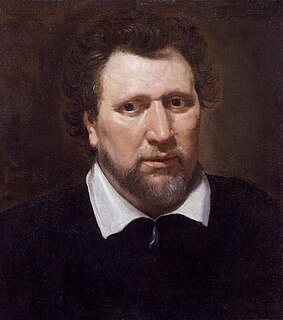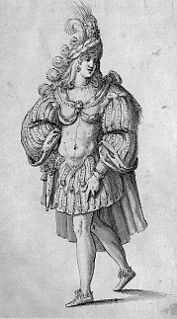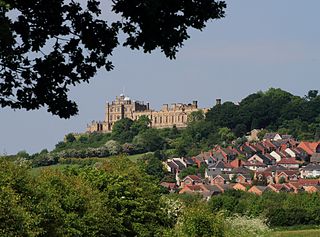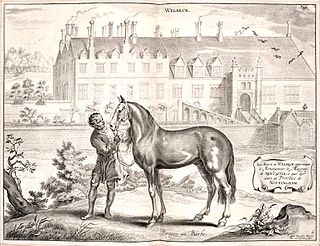Related Research Articles

Benjamin Jonson was an English playwright and poet. Jonson's artistry exerted a lasting influence upon English poetry and stage comedy. He popularised the comedy of humours; he is best known for the satirical plays Every Man in His Humour (1598), Volpone, or The Fox, The Alchemist (1610) and Bartholomew Fair (1614) and for his lyric and epigrammatic poetry. "He is generally regarded as the second most important English dramatist, after William Shakespeare, during the reign of James I."

The masque was a form of festive courtly entertainment that flourished in 16th- and early 17th-century Europe, though it was developed earlier in Italy, in forms including the intermedio. A masque involved music and dancing, singing and acting, within an elaborate stage design, in which the architectural framing and costumes might be designed by a renowned architect, to present a deferential allegory flattering to the patron. Professional actors and musicians were hired for the speaking and singing parts. Often the masquers, who did not speak or sing, were courtiers: the English queen Anne of Denmark frequently danced with her ladies in masques between 1603 and 1611, and Henry VIII and Charles I of England performed in the masques at their courts. In the tradition of masque, Louis XIV of France danced in ballets at Versailles with music by Jean-Baptiste Lully.
This article contains information about the literary events and publications of 1634.
This article presents lists of the literary events and publications in 1633.

Hymenaei, or The Masque of Hymen, was a masque written by Ben Jonson for the marriage of Robert Devereux, 3rd Earl of Essex, and Lady Frances Howard, daughter of the Earl of Suffolk, and performed on their wedding day, 5 January 1606. The costumes, sets, and scenic effects were designed by Inigo Jones, and the music composed by Alfonso Ferrabosco.
A Tale of a Tub is a Caroline era stage play, a comedy written by Ben Jonson. The last of his plays to be staged during his lifetime, A Tale of a Tub was performed in 1633 and published in 1640 in the second folio of Jonson's works.
Love's Welcome at Bolsover is the final masque composed by Ben Jonson. It was performed on 30 July 1634, three years before the poet's death, and published in 1641.

Ben Jonson collected his plays and other writings into a book he titled The Workes of Benjamin Jonson. In 1616 it was printed in London in the form of a folio. Second and third editions of his works were published posthumously in 1640 and 1692.
Chloridia: Rites to Chloris and Her Nymphs was the final masque that Ben Jonson wrote for the Stuart Court. It was performed at Shrovetide, 22 February 1631, with costumes, sets and stage effects designed by Inigo Jones.
Love Freed from Ignorance and Folly was a Jacobean era masque, written by Ben Jonson and designed by Inigo Jones, with music by Alfonso Ferrabosco. It was performed on 3 February 1611 at Whitehall Palace, and published in 1616.
Neptune's Triumph for the Return of Albion was a Jacobean era masque, written by Ben Jonson, and designed by Inigo Jones. The masque is notable for the contradictory historical evidence connected with it and the confusion it caused among generations of scholars and critics.
The Masque of Augurs was a Jacobean era masque, written by Ben Jonson and designed by Inigo Jones. It was performed, most likely, on Twelfth Night, 6 January 1622.
Luminalia or The Festival of Light was a late Caroline era masque or "operatic show", with an English libretto by Sir William Davenant, designs by Inigo Jones, and music by composer Nicholas Lanier. Performed by Queen Henrietta Maria and her ladies in waiting on Shrove Tuesday, 6 February 1638, it was one of the last and most spectacular of the masques staged at the Stuart Court.
Christmas, His Masque, also called Christmas His Show, was a Jacobean-era masque, written by Ben Jonson and performed at the English royal court at Christmas of 1616. Jonson's masque displays the traditional folklore and iconography of Christmas at an early-modern and pre-commercial stage of its development.
Lovers Made Men, alternatively titled The Masque of Lethe or The Masque at Lord Hay's, was a Jacobean era masque, written by Ben Jonson, designed by Inigo Jones, and with music composed by Nicholas Lanier. It was performed on Saturday 22 February 1617, and was significant in the development and acceptance of opera in seventeenth-century England.

Sir Charles Cavendish was an English aristocrat, Member of Parliament for Nottingham, and patron.
Walter Warner (1563–1643) was an English mathematician and scientist.
The Great Tew Circle was a group of clerics and literary figures who gathered in the 1630s at the manor house of Great Tew, Oxfordshire in southern England, and in London.

The Welbeck Academy or Welbeck Circle is a name that has been given to the loose intellectual grouping around William Cavendish, 1st Duke of Newcastle-upon-Tyne in the first half of the 17th century. It takes its name from Welbeck Abbey, a country house in Nottinghamshire that was a Cavendish family seat. Another term used is Newcastle Circle. The geographical connection is, however, more notional than real; and these terms have been regarded also as somewhat misleading. Cavendish was Viscount Mansfield in 1620, and moved up the noble ranks to Duke, step by step; "Newcastle" applies by 1628.
The Entertainment at Britain’s Burse is a masque written by Ben Jonson in 1609 and rediscovered in 1997. It was commissioned by Robert Cecil, 1st Earl of Salisbury, in celebration of the opening of the “New Exchange”. This masque was discovered by James Knowles and published in 1997. It is an unusual Johnson text because it seems to be in celebration of consumer culture while so many of his other plays and poems condemn it—though there might be some satire intended. There are essentially only three characters. Each character performs a rather lengthy monologue including two songs by the final actor.
References
- ↑ Henry Ten Eyck Perry, The First Duchess of Newcastle and her Husband as Figures in Literary History, Boston, Ginn and Co., 1918; pp. 92–3.
- ↑ Julie Sanders, "Jonson's Caroline Coteries," In: Shakespeare, Marlowe, Jonson: New Directions in Biography, Takashi Kozuka and J. R. Mulryne, eds., London, Ashgate, 2006; p. 285.
- ↑ Perry, pp. 86–8, 90–1.
- ↑ Leah Sinanoglou Marcus, The Politics of Mirth: Jonson, Herrick, Milton, Marvell, and the Defense of Old Holiday Pastimes, Chicago, University of Chicago Press, 1986; pp. 128–9.
- ↑ A. P. Martinich, "Thomas Hobbes in Ben Jonson's The King's Entertainment at Welbeck," Notes and Queries Vol. 45 No. 3 (Sept. 1998), p. 370.
- ↑ Perry, pp. 122–6, 128–32, and ff.